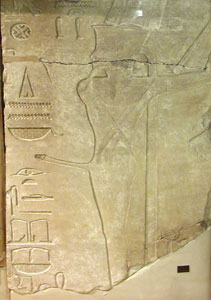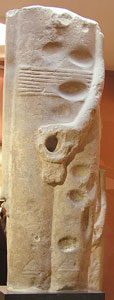
Min (Menew, Menu, Amsu) was an ancient Egyptian god whose worship dates back to the predynastic times. His early images are the oldest examples of large scale statuary found in Egypt so far. He was worshipped by King Scorpion of the Early Dynastic Period and his symbol appears on the El Amrah palette (which is also known as the min palette). His cult may have developed from the worship of his fetish, which was thought to be a barbed arrow, a thunderbolt, or a fossilized belemnite (an ancient relative of the cuttlefish).
As time progressed, he was given a human form and represented by the Min standard which resembles a double-headed arrow on a hook. Alternatively, Min initially represented the constellation Orion and was thought to control thunder and rain (linking him to Set). This connection with Orion also connected Min with Horus because the three were depicted with their arms raised above their head (a pose linked to the “smiting” pose of the pharaoh) and later provided a connection with Osiris.

Min continued to be associated with Horus until the Middle Kingdom when he became more closely associated with fertility and the solar aspects of Horus were emphasised. Min was associated with Amun during the New Kingdom, partly because both were linked to the ram and the bull, both of which were seen as a symbols of virility. The composite god Amun-Min was known as Kamutef (“Bull of his mother”).
In later periods, Min was linked to Reshep, the Semitic god of war and thunder. Both gods were thought to be married to Qadesh the Semitic love goddess, although Min was often considered to be the child of Reshep and Qadesh. It is perhaps unsurprising that the Greeks linked Min to their fertility god, Pan. Because of this association, they renamed named Akhmim, Panopolis (city of Pan).
He was a god of the Eastern Desert, and a god and patron of traveling caravans. A reference in the Pyramid Texts to “the one who raises his arm in the east” is thought to relate to Min. He offered protection to travellers and traders and was also worshiped by the miners and masons who worked around the Wadi Hammamat. In this area, he was known as “Min, the (foremost) Man of the Mountain”. His association with the desert led to an association with foreign lands and with the god Set.
Although he was associated with the desert, Min was a god of fertility and sexuality. He was associated with the Egyptian long-leaf lettuce (also a favourite food of Set) which was considered to be an aphrodisiac, as it secreted a milky substance which was likened to semen. Min was often shown standing before offering tables, covered with heads of lettuce.
At the beginning of the harvest season, Min’s statue was carried through the fields in a festival known as “the departure of Min”. Min blessed the harvest and the people held games in his honour, most of which involved the menfolk climbing a huge pole (which had a connection with fertility not unlike the maypole). It is thought that this related to the construction of a huge festival pavilion where the festivities were held.

Min was closely associated with fertility and agriculture, and so with Osiris. In depictions of one of Min’s festivals, the pharaoh hoes and waters the ground while Min watches. In another, the pharaoh ceremonially reaps the grain. However, Min was not just a fertility god, but a patron of male sexuality who could help men to father children. When the pharaoh successfully fathered an heir he was identified with the god, and a virginal girl was sometimes called an “unploughed field”. As he represented male virility, it is not surprising that it was Min who presided over the Heb Sed festival, in which the pharaoh ran a course carrying ritual objects to rejuvenate him and to prove his virility.
During the New Kingdom, the pharaoh was expected to sow his seed metaphorically using plant seeds to prove that he was fertile, although some scholars suggest that the pharaoh was also expected to prove that he was still sexually potent by ejaculating. He was also a lunar god (relating him to moisture and fertility) and was given the epithet, “Protector of the Moon”. The last day of the lunar month was sacred to Min and by the Ptolemaic period, he was patron of the fifth month of the Egyptian calendar (called Tybi by the Greeks).
Min was generally thought to be the son and husband of the goddess of the east, Iabet. However, in Gebtu (which was the cult site of both Min and Isis) Min was considered to be the husband of Isis and the father of Horus (again associating him with Osiris). In Memphis he was associated with Ptah as the composite god Ptah-Min. He was also linked to a number of leonine warlike goddesses (particularly Sekhmet). As a result, the body of Min is sometimes given the head of a lioness. He was also associated with the composite deity Mut–Isis–Nekhbet, known as “the Great Mother and Lady”. This deity was depicted as a winged goddess with leonine feet, an erect penis, and three heads (the head of a lion head wearing Min’s headdress, a woman’s head wearing the double crown of Egypt, and a vulture’s head wearing the red crown of Lower Egypt).
Min was generally depicted as a mummiform human man with an ithyphallic (erect and uncovered) penis wearing a crown with two large feathers (like that of Amun). In his left hand he holds his penis (although this is usually only apparent in statues because of the perspective applied to two dimensional images in Egyptian Art) and in his right hand he holds a flail up above his shoulder. The flail represents Pharonic power and fertility (it was used to thresh corn and remove the husk) and it is suggested that the position of his arm replicates the stance associated with Orion and that the position of his arm in relation to the flail represents sexual intercourse (with the flail representing a vagina and his arm representing his penis).
Min’s skin is black (linking him to fertile black soil). Occasionally, he wears a red ribbon which may represent sexual power. When he takes the form of Amun-Min, he sometimes wears a sun disk between the two feathers on his headdress. In both Akhmin and Coptos he was worshipped in the form of a white bull (representing virility) known as “Bull of the Great Phallus” and in Heliopolis he was associated with the Mnevis bull cult. When he is represented as the constellation Orion he can be distinguished from Osiris because the three bright stars of Orion’s belt are made to represent his erect penis.
Because of his rather noticeable genitalia, images of Min were subject to a great deal of damage at the hands of more prudish Christians immigrants and during the Victorian period Egyptologists regularly omitted the lower part of his body in photographs and drawings. In a final insult to the god, nineteenth century scholars mistranslated his name as Khem (or Chem meaning “black” in Egyptian). This was in fact one of his epithets which related to his fertility aspect because black was associated with the fertile soil of the Nile. This black soil was so central to the Egyptian way of life that the word also became a common term for the land of Egypt itself.
Min’s cult center was Gebtu (Koptos), the capital of the fifth Nome of Upper Egypt, but in later times he was also associated with Khent-Min (Panopolis, Akhmim) the capital of the ninth Nome of Upper Egypt.
Bibliography
- The Complete Gods and Goddesses of Ancient Egypt (2003) Richard H. Wilkinson
- God’s Wife, God’s Servant: The God’s Wife of Amun (2009) Mariam F. Ayad
- Ancient Egyptian Literature: Volume I: The Old and Middle Kingdoms (2006) Miriam Lichtheim
- Egyptian Mythology (1997) Simon Goodenough
- Gods of Ancient Egypt (1996) Barbara Watterson
Copyright J Hill 2015